Roaring Twenties
> Shutrbugjo
> PATHFINDERS
Great Gatsby Treasure Hunt. This treasure hunt was originally authored by Valerie Arbizu, with some alterations and updated links.
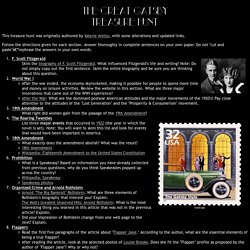
Follow the directions given for each section. Answer thoroughly in complete sentences on your own paper. Do not "cut and paste"—rephrase the answers in your own words. F.
1920s Webquest. 1920s-Webquest. 1920s Consumer Culture. To introduce students to the importance of consumerism in the 1920s, when there was a shift from "inner-directed" to "outer-directed" ways of self-improvement.To have students recognize the connections between commodities and culture in the American past, and present.To improve students’ abilities to analyze and interpret historical documents and images.
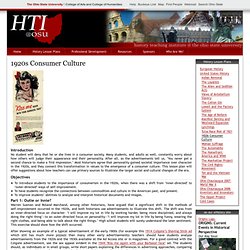
Part 1: Outie or Innie?
Clash of Cultures Homepage. Great War & Jazz Age (1914-1928)
American Cultural History - Decade 1920-1929. Early modernism in art, design, and architecture, which began at the turn of the century, continued through to 1940 and the war.
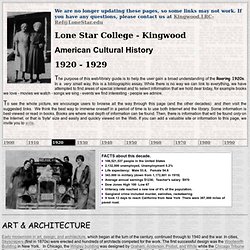
In cities, Skyscrapers (first in 1870s) were erected and hundreds of architects competed for the work. The first successful design was the Woolworth Building in New York. In Chicago, the Wrigley building was designed by Graham, Anderson, Probst, and White while the Chicago Tribune Tower was designed by Howells and Hood. The Art Deco design was exemplified by the Chrysler and Empire State Buildings (depression projects - the Empire State Building completed early 1931.) Frank Lloyd Wright was prolific during this period, designing homes in California and in Japan.
Art movements included the modernist movement [George Luks, Charles W. World Wide Art Resources from the Metropolitan Museum of Art | Searchable by artists, movement, galleries, museums, architecture. 1925 The Year in Review | Texas.net Museum of Art - an online art museum.Books e.e. cummings. Digital History. Teaching Modules.
During the 1920s jazz was by far the most important and controversial form of cultural production in the United States.
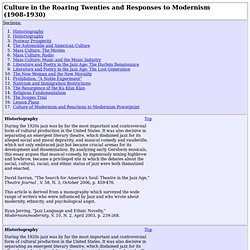
It was also decisive in separating an emergent literary theatre, which disdained jazz for its alleged social and moral depravity, and musical comedy and vaudeville, which not only embraced jazz but became crucial arenas for its development and dissemination.
The Roaring Twenties. See if you have what it takes to survive the Roaring Twenties!
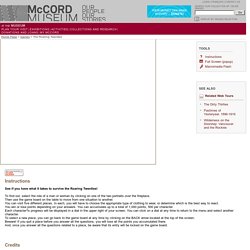
To find out, select the role of a man or woman by clicking on one of the two portraits over the fireplace.Then use the game board on the table to move from one situation to another.You can visit five different places. In each, you will have to choose the appropriate type of clothing to wear, or determine which is the best way to react.You win or lose points depending on your answers. You can accumulate up to a total of 1,000 points, 500 per character.Each character?
S progress will be displayed in a dial in the upper right of your screen.
You can click on a dial at any time to return to the menu and select another character.To select a new place, you can go back to the game board at any time by clicking on the BACK arrow located at the top of the screen.Beware!
Browse by Topic (Library of Congress) - American History - Progressive Era to New Era, 1900-1929. These pages link to selected collection content available online at the Library of Congress, arranged by broad categories.
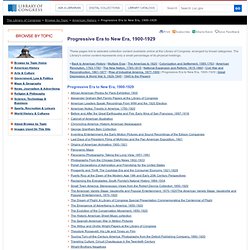
The Library's online content represents only a small percentage of its physical holdings.
1920s and 1930s Pathfinder - Valley View's Library Media Center. 1920's Pathfinder. 1921-1929. Great Gatsby Treasure Hunt. The Lawless Decade By Paul Sann. Search Results for "roaring twenties"
Fads and Heroes. New American hero, Charles Lindbergh, is honored with a ticker-tape parade in New York City on June 13, 1927, after returning from the world's first solo transatlantic flight in the Spirit of St.

Louis. The Roaring Twenties was a time of great change. As exciting as dynamic times may seem, such turmoil generates uncertainty. Sometimes, in an effort to obscure tensions, people seek outlets of escape. Fads — sometimes entertaining, sometimes senseless — swept the nation.
The 1920s Summary & Analysis. The Roaring Twenties - Facts & Summary. The Roaring 20s and Prohibition: The Roaring '20s and Prohibition. Smithsonian's History Explorer: 1920s Industrial America Classroom Activity Guide. Clash of Cultures Homepage. The Lawless Decade By Paul Sann. The Great Gatsby - Preparation - Lesson Plans - For Teachers. JAZZ A Film By Ken Burns: Jazz in Time - Roaring Twenties.
Roaring Twenties excerpted from Jazz: A History of America's Music.
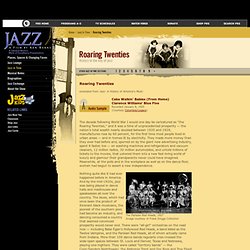
The Roaring Twenties. US History, American History. Roaring Twenties. The 1920s era went by such names as the Jazz Age, the Age of Intolerance, and the Age of Wonderful Nonsense.
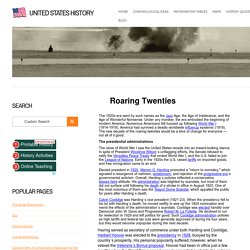
Under any moniker, the era embodied the beginning of modern America. Numerous Americans felt buoyed up following World War I (1914-1918). America had survived a deadly worldwide influenza epidemic (1918). The new decade of the roaring twenties would be a time of change for everyone — not all of it good.
Sage American History. American Cultural History - Decade 1920-1929. Clarence Darrow's and Robert Crowe's Summations in the Leopold and Loeb Trial. The 1920s - Also known as the Roaring Twenties.
F.Scott Fitzgerald Centenary. Temperance & Prohibition. Today in History: July 30. Henry Ford Old Zeke Perkins sold his hogs the other day, The gosh-darned fool threw his money right away; Rode into town, sittin' on a board, Came home ridin' in a brand-new Ford!
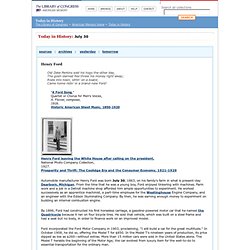
Automobile manufacturer Henry Ford was born July 30, 1863, on his family's farm in what is present-day Dearborn, Michigan. From the time that he was a young boy, Ford enjoyed tinkering with machines. Farm work and a job in a Detroit machine shop afforded him ample opportunities to experiment. He worked successively as an apprentice machinist, a part-time employee for the Westinghouse Engine Company, and an engineer with the Edison Illuminating Company.
By 1896, Ford had constructed his first horseless carriage, a gasoline-powered motor car that he named the Quadricycle because it ran on four bicycle tires.
Fixing Cars. Photographs from the Golden Age of Jazz. The Library of Congress Music Division, Library of Congress Search by Keyword | Browse by Name | Subject | Venue. Harlem Renaissance. During the early 20th century, African-American poets, musicians, actors, artists and intellectuals moved to Harlem in New York City and brought new ideas that shifted the culture forever. During the early 20th century, African-American poets, musicians, actors, artists and intellectuals moved to Harlem in New York City and brought new ideas that shifted the culture forever. From approximately 1918 to the mid 1930s, talent began to overflow within this newfound culture of the black community in Harlem, as prominent figures—Langston Hughes, Duke Ellington and Billie Holiday, to name a few—pushed art to its limit as a form of expression and representation.
Infamous Mobsters. Bootleggers, smugglers, drug dealers, hit men—all these occupations are the provenance of mobsters, who operate in ethnic, family and business networks. Bootleggers, smugglers, drug dealers, hit men—all these occupations are the provenance of mobsters, who operate in ethnic, family and business networks. Mobsters' real life crimes, and Hollywood's fascination with them, has earned them a special place in the American imagination. From Al Capone's Chicago crime ring to Bugsy Siegel's Las Vegas racket, these mobsters have made their names notorious from coast to coast.
Icons of the Roaring Twenties. Just hearing the name F. Scott Fitzgerald evokes the echo of clinking martini glasses, the fizz-pop of champagne, tinkling chandeliers, and the strains of hot jazz sliding forth from a glistening trombone. Sleek women in satin and chiffon dance wildly, beads flying furiously.
Ah, but that would be Zelda, his wife.
Langston Hughes Biography. “An artist must be free to choose what he does, certainly, but he must also never be afraid to do what he might choose.” “I have discovered in life that there are ways of getting almost anywhere you want to go, if you really want to go.”
Fatal Flood . American Experience . WGBH. Scopes Trial Home Page - UMKC School of Law. The American Experience. KansasCity.com : Kansas City breaking local news, sports, entertainment, business.
Hemingwayhome.com. Biography of F. Scott Fitzgerald. By Matthew J. Bruccoli The dominant influences on F.
Zora Neale Hurston - Home. Library System - Howard University. A Centennial Tribute to Langston Hughes. The Harlem Renaissance - Primary Source Set. Red Scare (1918-1921): Home Page. The Roaring Twenties. The Herbert Hoover Presidential Library and Museum. The Roaring '20s and Prohibition.










